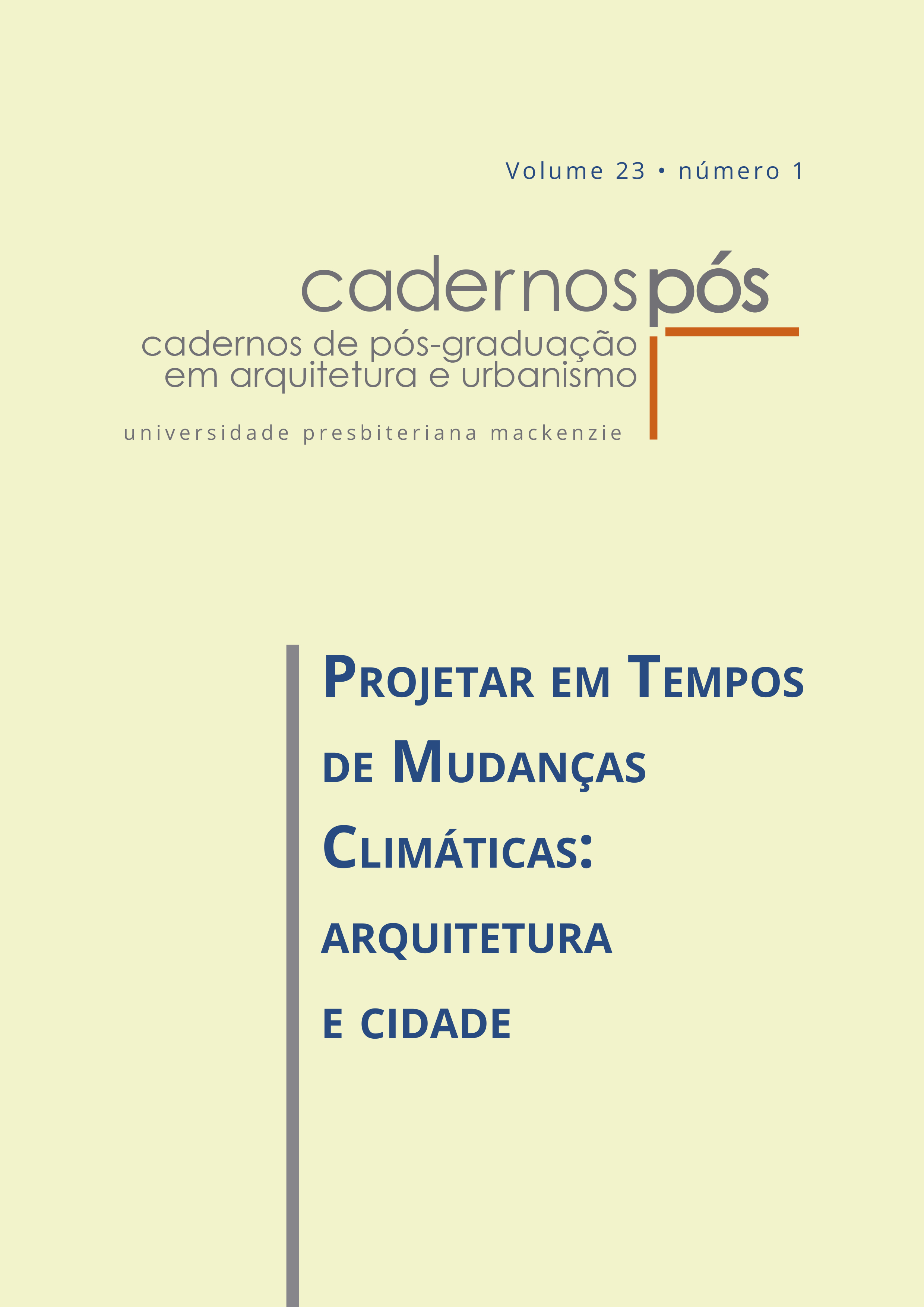Influência da morfologia urbana no desempenho térmico dos edifícios
um olhar no presente e em prospecções climáticas futuras
DOI:
https://doi.org/10.5935/cadernospos.v23n1p55-69Palavras-chave:
Mudanças climáticas; Conforto adaptativo; Cenários urbanos.Resumo
As mudanças climáticas são um desafio-chave global no século XXI e o desenho urbano pode potencializar esses impactos. Este trabalho tem como objetivo avaliar a influência das mudanças climáticas nas condições térmicas internas de edificações, considerando diferentes morfologias urbanas. O processo metodológico consiste em: i) estruturação e definição de nove cenários urbanos; ii) geração dos arquivos climáticos futuros, utilizando como base o RCP4.5 e projeção climática de 2035; e iii) definição dos limites de conforto e desconforto térmico por meio do modelo adaptativo. Os resultados mostram que as mudanças climáticas irão impactar as condições interna dos edifícios, principalmente na aceitabilidade térmica dos usuários. Em Cuiabá, os cenários urbanos 1, 2 e 3 ultrapassam o limite superior em setembro, apresentando desconforto por calor no período histórico e em 2035. Em Florianópolis o mês de maio no período histórico fica abaixo do limite inferior, em 2035 se enquadra dentro da faixa de conforto, ou seja, tornando-se mais quente. Destaca-se que a influência do sombreamento, como nos cenários 1A, 2C e 3A do entorno reduz as horas em desconforto por calor e aumenta as horas em conforto térmico no modulo.
Downloads
Referências
AMADO, M.; POGGI, F.; AMADO A. R.; BREU, S. E-city web platform: a tool for energy efficiency at urban level. Energies, v. 11, n. 7, p. 1-14, 2018. DOI 10.3390/en11071857
ARBOIT, M.; MESA, A.; DIBLASI, A.; LLANO, J. C. F.; ROSA, C. de. Assessing the solar potential of low-density urban environments in Andean cities with desert climates: the case of the city of Mendoza, in Argentina. 2. part. Renewable Energy, v. 35, n. 7, p. 1551-1558, 2010. DOI 10.1016/j.renene.2009.11.027
ASHRAE. ASHRAE Standard 55: thermal environmental conditions for human occupancy. Georgia, 2013.
BELCHER, S. E.; HACKER, J. N.; POWELL, D. S. Constructing design weather data for future climates. Building Services Engineering Research and Technology, v. 26, n. 1, p. 49-61, 2005. DOI 10.1191/0143624405bt112o
BRASIL. INSTITUTO NACIONAL DE METROLOGIA, QUALIDADE E TECNOLOGIA, (INMETRO). Portaria n° 42, de 24 de fevereiro de 2021. Aprova a Instrução Normativa Inmetro para a Classificação de Eficiência Energética de Edificações Comerciais, de Serviços e Públicas (INI-C) que aperfeiçoa os Requisitos Técnicos da Qualidade para o Nível de Eficiência Energética de Edifícios Comerciais, de Serviços e Públicos (RTQ-C), especificando os critérios e os métodos para a classificação de edificações comerciais, de serviços e públicas quanto à sua eficiência energética. Brasília, DF: Diário Oficial da União, 2021.
EICKER, U.; MONIEN, D.; DUMINIL, E.; NOUVEL, R. Energy performance assessment in urban planning competitions. Applied Energy, v. 155, p. 323-333, 2015. DOI 10.1016/j.apenergy.2015.05.094
FONSECA, J. A.; NGUYEN, T-A.; SCHLUETER, A.; MARECHAL, F. City Energy Analyst (CEA): integrated framework for analysis and optimization of building energy systems in neighborhoods and city districts. Energy and Buildings, v. 113, p. 202-226, 2016. DOI 10.1016/j.enbuild.2015.11.055
GUARDA, E. L. A. da. et al. The influence of climate change on renewable energy systems designed to achieve zero energy buildings in the present: a case study in the Brazilian Savannah. Sustainable Cities and Society, v. 52, n. 101843, 2020. DOI 10.1016/j.scs.2019.101843
INTERGOVERNMENTAL PANEL ON CLIMATE CHANGE (IPCC). Fifth Assessment Report. Genova, Suíça, 2014.
MARTINS, T. A. L.; ADOLPHE, L.; BASTOS, L. E. G.; MARTINS, M. A. L. Sensitivity analysis of urban morphology factors regarding solar energy potential in a Brazil tropical context. Solar Energy, v. 137, p. 11-24, 2016. DOI 10.1016/j.solener.2016.07.053
PEEL, M. C.; FINLAYSON, B. L.; MCMAHON, T. A. Updated world map of the Köppen-Geiger climate classification. Hydrology and Earth System Sciences, v. 11, p. 1633-1644, 2007. DOI 10.5194/hess-11-1633-2007
SARRALDE, J. J.; QUINN, D. J.; WIESMANN, D.; STEEMERS, K. Solar energy and urban morphology: scenarios for increasing the renewable energy potential of neighbourhoods in London. Renewable Energy, v. 73, p. 10-17, 2015. DOI 10.1016/j.renene.2014.06.028
SAVVIDES, A.; VASSILIADES, C.; MICHAEL A.; KALOGIROU, S. Siting and buildingmassing considerations for the urban integration of active solar energy systems. Renewable Energy, v. 135, p. 963-974, 2019. DOI 10.1016/j.renene.2018.12.017
SHI, Z.; FONSECA, J. A.; SCHLUETER, A. A parametric method using vernacular urban block typologies for investigating interactions between solar energy use and urban design. Renewable Energy, v. 165, part. 1, p. 823-841, 2021.DOI 10.1016/j.renene.2020.10.067
TRIANA, M. A.; LAMBERTS, R.; SASSI P. Should we consider climate change for Brazilian social housing? Assessment of energy efficiency adaptation measures. Energy and Buildings, v. 158, p. 1379-1392. 2018. DOI 10.1016/j.
enbuild.2017.11.003
VAN HOOF, T.; BLOCKEN, B.; TIMMERMANS, H. J. P.; HENSEN, J. L. M. Analysis of the predicted effect of passive climate adaptation measures on energy demand for cooling and heating in a residential building. Energy, v. 94,
p. 811-820, 2016. DOI 10.1016/j.energy.2015.11.036
VUKMIROVIC, M.; GAVRILOVIC, S.; STOJANOVIC, D. The improvement of the comfort of public spaces as a local initiative in coping with climate change. Sustainability, v. 11, n. 23, 2019. DOI 10.3390/su11236546
ZHANG, J. et al. Impact of urban block typology on building solar potential and energy use efficiency in tropical high-density city. Applied Energy, v. 240, p. 513-533, 2019. DOI 10.1016/j.apenergy.2019.02.033
Downloads
Publicado
Como Citar
Edição
Seção
Licença
Copyright (c) 2023 Emeli Guarda, Renata Domingos, Martin Mizgier

Este trabalho está licenciado sob uma licença Creative Commons Attribution 4.0 International License.
Autores que publicam nesta revista concordam com os seguintes termos:
a) Autores mantém os direitos autorais e concedem à revista o direito de primeira publicação, com o trabalho simultaneamente licenciado sob a Licença Creative Commons Attribution que permite o compartilhamento do trabalho com reconhecimento da autoria e publicação inicial nesta revista.
b) Autores têm autorização para assumir contratos adicionais separadamente, para distribuição não-exclusiva da versão do trabalho publicada nesta revista (ex.: publicar em repositório institucional ou como capítulo de livro), com indicação de que foi publicado originalmente nesta revista, com link para o artigo.








 Todo o conteúdo de Cadernos de Pós-Graduação em Arquitetura e Urbanismo está licenciado sob
Todo o conteúdo de Cadernos de Pós-Graduação em Arquitetura e Urbanismo está licenciado sob 